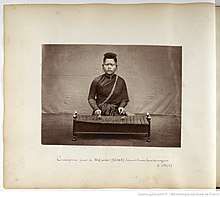Roneat thong

Female musician playing roneat dek (រនាតដែក) or roneat thong (រនាតថោង) metallophone at the Cambodian court, c. 1860s or 1870s. Image from French photographer Émile Gsel (1838-1879).
The roneat thong (រនាតថោង) is a Cambodian metallophone, similar to the roneat dek.[1] Both use as their standard, 21 "individually toned", "trough shaped" soundbars.[1]
The two instruments use different metals for their chime-bars.[1] The roneat thong uses brass, which might also be bronzed or made scarlet or gold.[1] In contrast, the roneat dek uses tone bars of blackened iron.[1] The original "standard" for the Cambodian metallphones was the iron bars, but in later times the softer, easier to work metal came to be used.[1]
References
- 1 2 3 4 5 6 "ឧបករណ៍ភ្លេង រនាតថោង និងរនាតដែក [Devices, brackets, and armature]". choukmer.wordpress.com. Retrieved 4 October 2018.
Thong gamelan and iron gamelan is a tonal gamelan 21 same trough-shaped purely individual tonal sound the same but called gamelan Thong from gamelan tonality made of bronze colored scarlet color analogous gold, while iron gamelan gamelan is a tonal solid iron with black opaque.
zero width space character in|title=at position 7 (help)
See also
This article is issued from
Wikipedia.
The text is licensed under Creative Commons - Attribution - Sharealike.
Additional terms may apply for the media files.